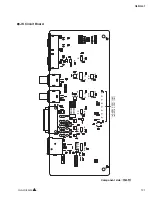
Chapter 6 DeviceNet
Manual VIPA System 200V
6-4
HB97E - IM - Rev. 06/29
DeviceNet employs a master line/tap line topology with up to 64 network
nodes. The maximum distance is either 500m at a rate of 125kBaud, 250m
at a rate of 250kBaud or 100m at a rate of 500kBaud.
The length of the tap lines can be up to 6m while the total length of all spur
lines depends on the baudrate.
Network nodes can be removed from or inserted into the network without
interruption of the network operation. New stations and failed stations are
detected automatically.
DeviceNet employs a screened five-core cable as data communication
medium.
DeviceNet uses voltage differences and for this reason it exhibits less
sensitivity to interference than a voltage or current based interface.
Signals and power supply conductors are included in the same network
cable. It is therefore possible to connect devices that obtain the operating
voltage via the network as well as devices with an integrated power supply.
Furthermore it is possible to connect redundant power supplies to the
network that guarantees the power supply when required.
DeviceNet operates according to the Carrier-Sense Multiple Access
(CSMA) principle, i.e. every station on the network may access the bus
when it is not occupied (random access).
The exchange of messages is message orientated and not station
orientated. Each message is provided with a unique and priorizing
identifier. At any time only one station is able to occupy the bus with its
messages.
The DeviceNet bus access control is subject to non-destructive, bit-wise
arbitration. In this case non-destructive means that the successful station
participating in the arbitration doesn't need to re-send its message. The
most important station is selected automatically when multiple stations
access the bus simultaneously. If a station that is ready to send recognizes
that the bus is occupied, its send request is delayed until the current
transfer has been completed.
All stations on the bus must be uniquely identified by means of an
ID address. Every DeviceNet device has addressing facilities.
The properties of the DeviceNet units are supplied in the form of an EDS
file (
E
lectronic
D
ata
S
heet) to configure a slave interface by means of your
configuration tool.
Communication
medium
Bus access
method
Addressing
EDS file
Summary of Contents for System 200V IM Series
Page 1: ...Manual VIPA System 200V IM Order No VIPA HB97E_IM Rev 06 29...
Page 2: ...Lerrzeichen...
Page 6: ...About this manual Manual VIPA System 200V Subject to change to cater for technical progress...
Page 10: ...Contents Manual VIPA System 200V iv HB97E IM Rev 06 29...
Page 18: ...Chapter 1 Basics Manual VIPA System 200V 1 6 HB97E IM Rev 06 29...
Page 136: ...Chapter 3 Profibus DP Manual VIPA System 200V 3 104 HB97E IM Rev 06 29...
Page 338: ...Chapter 8 Ethernet coupler Manual VIPA System 200V 8 34 HB97E IM Rev 06 29...
Page 344: ...Chapter 9 Bus expansion modules IM 260 IM 261 Manual VIPA System 200V 9 6 HB97E IM Rev 06 29...
















































